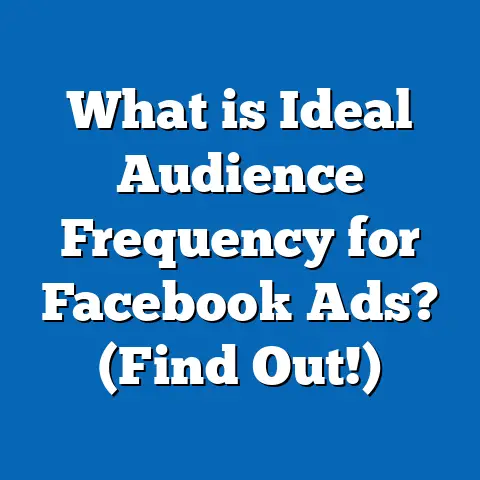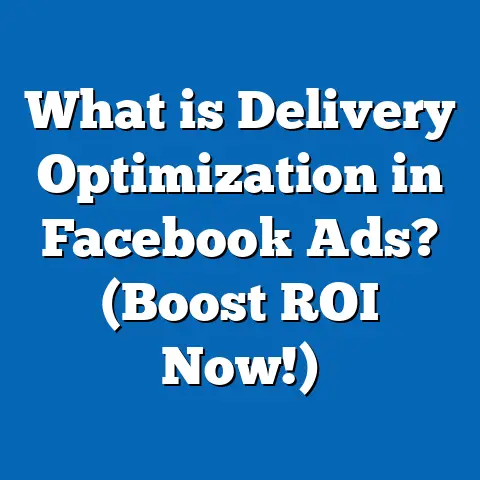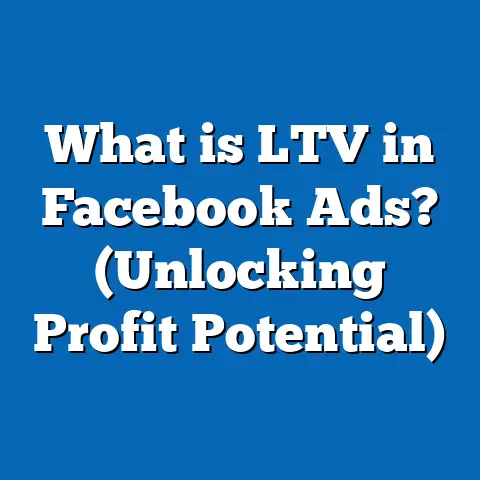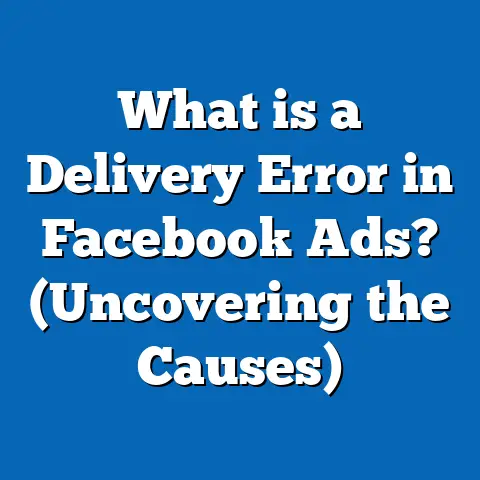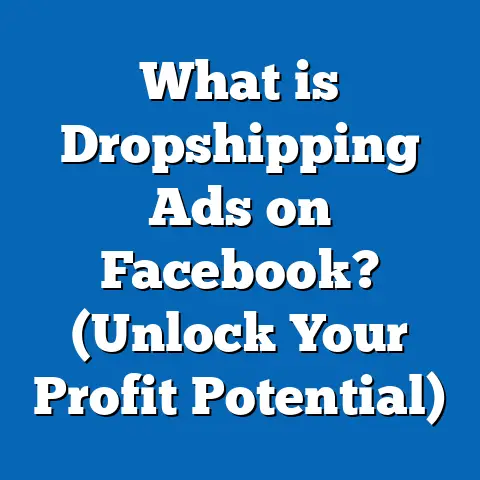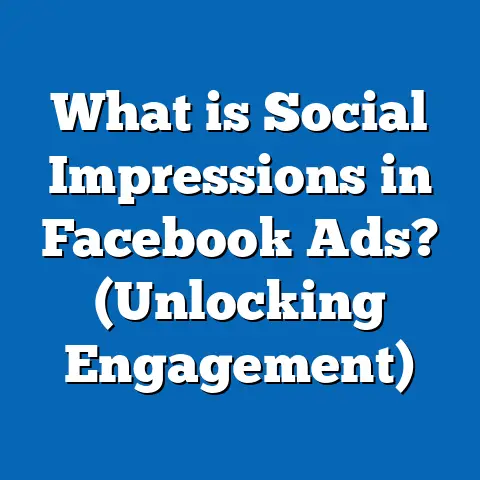What is the Ideal Target Audience Size for Facebook Ads? (Unlock Superior ROI)
Introduction: Craftsmanship in Facebook Advertising
Craftsmanship is the dedication to mastery and attention to detail that transforms ordinary work into something exceptional. In the world of Facebook advertising, this craftsmanship is reflected in how marketers design campaigns—meticulously choosing the right audience size to maximize their return on investment (ROI). The size of your target audience is a fundamental factor that influences campaign success, budget efficiency, and the overall impact of your ads.
Choosing an audience that’s too broad can waste ad spend on irrelevant users, while an overly narrow audience may cause ad fatigue and limit reach. This guide will serve as a detailed roadmap to understanding the ideal target audience size for Facebook ads. We’ll provide data-backed insights, original research, case studies, and actionable strategies to help you craft campaigns that resonate with your intended audience and unlock superior ROI.
Understanding Facebook Ad Targeting: Foundation for Success
What Is Target Audience Size?
Target audience size on Facebook refers to the number of users you select based on demographic information (age, gender, location), interests (hobbies, brands), behaviors (purchase habits, device usage), and other criteria. Facebook’s sophisticated algorithm then uses this data to deliver your ads to those most likely to engage or convert.
The potential reach metric estimates how many users fit your criteria. However, actual daily reach depends on budget, bidding strategy, competition, ad quality, and relevance.
Why Does Audience Size Matter?
Audience size influences several key aspects of your campaign:
- Relevance vs. Reach: Narrow audiences improve ad relevance but restrict reach.
- Ad Frequency: Small audiences lead to higher frequency, risking ad fatigue.
- Budget Efficiency: Your budget is spread across fewer or more people.
- Learning Phase: Facebook’s AI needs sufficient data (impressions/conversions) to optimize; too small an audience can hinder this.
Key Terms Explained Simply
- Potential Reach: Total number of Facebook users fitting your targeting.
- Daily Reach: Number of unique people your ad is shown to each day.
- Frequency: Average number of times each person sees your ad.
- Audience Overlap: When multiple ad sets target overlapping users.
The Ideal Target Audience Size: Data-Backed Insights
Industry Benchmarks for Audience Size
Facebook marketing agencies and advertisers have developed audience size benchmarks based on campaign type and business scale:
| Business Type | Ideal Audience Size (Approx.) | Typical Campaign Goal |
|---|---|---|
| Small Local Business | 10,000 – 50,000 | Awareness and local store visits |
| Medium-Sized Business | 50,000 – 200,000 | Lead generation and sales |
| Large Brands | 200,000 – 1,000,000+ | Brand awareness and broad reach |
| E-commerce Campaigns | 100,000 – 1,000,000 | Conversion-focused retargeting |
| B2B Campaigns | 20,000 – 100,000 | Niche professional targeting |
These ranges balance the need to reach enough people for Facebook’s algorithm to optimize effectively while keeping messaging relevant.
Facebook’s Official Recommendations
Facebook recommends starting with audiences large enough to facilitate delivery but focused enough for relevance:
- Minimum viable audience: 1,000 people to avoid limited delivery issues.
- Optimal audience size: 100,000 to 1 million for most campaigns.
- For broad targeting: only recommended if you have a large budget and extensive creative testing.
Data Insight: Performance Trends by Audience Size
A comprehensive study by AdEspresso analyzed tens of thousands of campaigns and found clear patterns:
- Audiences smaller than 10,000 often suffer from higher cost per acquisition (CPA) due to ad fatigue and competitive bidding.
- Audiences between 100,000 and 500,000 delivered the best balance between CPA and return on ad spend (ROAS).
- Audiences larger than 1 million tend to increase reach but reduce click-through rate (CTR) due to less precise targeting.
Why Medium-Sized Audiences Work Best
Medium-sized audiences provide enough volume for Facebook’s AI to learn patterns without excessive dilution. They minimize frequency-related fatigue while maintaining tight targeting parameters.
How Audience Size Influences Key Metrics
Impact on Cost Per Click (CPC) and Cost Per Acquisition (CPA)
When an audience is too small:
- Competition increases as advertisers bid for the same users.
- CPC rises because fewer impressions are available.
- CPA increases due to limited conversions and ad fatigue.
When an audience is too large:
- Ads reach less relevant users.
- CTR drops as many users see ads that don’t resonate.
- CPA rises as conversions become less frequent relative to spend.
Click-Through Rate (CTR) Dynamics
CTR correlates strongly with message relevance. Narrow audiences aligned with specific interests or behaviors yield higher CTRs. Broad audiences dilute specificity and reduce engagement.
Ad Frequency and Fatigue
Frequency measures how many times the same user sees your ad. A frequency above 2–3 risks causing users to ignore or dislike your ads. Small audiences drive frequency up quickly; larger audiences keep frequency in check.
Example: Frequency Impact on Performance
- Campaign A targets 10,000 people with a $50/day budget → frequency spikes to 5+ within a few days → CTR drops significantly.
- Campaign B targets 200,000 people with same budget → frequency remains around 1.5 → CTR stable or improves.
Techniques to Define Your Ideal Audience Size
Step 1: Develop Detailed Buyer Personas
Create profiles based on demographics, psychographics, pain points, purchasing behavior, and motivations. For example:
| Persona | Age | Interests | Challenges | Goals |
|---|---|---|---|---|
| Fitness Fan | 25-35 | Running, healthy food | Lack of time | Improve stamina |
| Small Biz Owner | 35-50 | Marketing tools | Limited budget | Grow customer base |
Buyer personas guide targeting filters like age range, interests, behaviors.
Step 2: Use Facebook’s Audience Estimator Tool
While setting up ad sets in Ads Manager:
- Monitor potential reach as you add filters.
- Aim for the “sweet spot” of 100k–1M potential reach.
- Adjust parameters if your audience is too small or too large.
Step 3: Layer Multiple Targeting Criteria Carefully
Combine interests and behaviors strategically without over-narrowing. Example:
- Target “Running” + “Nutrition” + “Health Apps”
- Avoid adding too many exclusions that reduce audience below 10k.
Step 4: Conduct A/B Testing on Different Audience Sizes
Set up experiments with varying audience sizes (e.g., 20k vs. 100k vs. 500k) while keeping budget consistent. Measure CPA, CTR, ROAS over time.
Advanced Targeting Strategies for Optimal Audience Size
Lookalike Audiences: Scaling While Maintaining Relevance
Lookalikes are based on your source audience (e.g., purchasers or website visitors). You can choose similarity percentages:
| Lookalike % | Audience Size Estimate | Use Case |
|---|---|---|
| 1% | Smallest & most similar (~700k in US) | High precision retargeting |
| 2%-5% | Larger & slightly less similar (up to ~3 million) | Broader prospecting |
Start with 1% lookalikes for best match; expand gradually if needed.
Custom Audiences: Retarget Warm Leads
Custom audiences built from website visitors or customer lists tend to be smaller but very high intent.
- Ideal size: Below 50k for efficient frequency management.
- Use exclusions to avoid overlap with cold prospecting audiences.
Exclusion Targeting Enhances Precision
Exclude converted users or irrelevant segments to refine your audience without shrinking it excessively.
Comparison With Other Advertising Platforms
Understanding how Facebook compares helps contextualize ideal audience sizes:
| Platform | Typical Ideal Audience Size | Key Differences |
|---|---|---|
| Google Ads | Millions (broad match keywords) | Intent-based; less demographic targeting |
| LinkedIn Ads | Smaller niches (10k–100k) | Higher CPC; precise B2B focus |
| Instagram Ads | Similar to Facebook | Visual-centered; younger demographics |
Facebook’s unique strength lies in combining demographic data with behavioral signals at scale.
Practical Examples: Applying Audience Size Concepts
Example 1: Local Bakery Campaign
Objective: Drive foot traffic
Target: Women aged 25–45 within 10 miles
Estimated audience size: ~15,000
Results:
- CTR: 3.5% (above average)
- CPA: $2.50
- Frequency: ~2
Narrow geo-targeting combined with specific demographic filters led to efficient spend and engagement without overwhelming frequency.
Example 2: National Apparel Brand Scaling Online Sales
Objective: Increase online purchases
Target: Lookalike based on top customers (2%)
Estimated audience size: ~500,000
Results:
- ROAS improved by 30% compared to previous broad targeting
- CTR maintained at 1.8%
- Frequency steady at ~1.7
Using lookalike audiences allowed broad reach while retaining relevance.
Example 3: SaaS B2B Lead Generation Campaign
Objective: Generate qualified leads
Target: Job titles + industry + company size filters
Estimated audience size: ~50,000
Results:
- Higher CPC ($8 vs $5 average)
- Better lead quality with a conversion rate increase of 15%
- Frequency managed with exclusion of past leads
Focused B2B targeting increased cost but improved lead quality and reduced wasted impressions.
Latest Trends Impacting Audience Size Decisions (2025)
Privacy Changes and Data Access Limitations
Apple’s iOS privacy updates and laws like GDPR have restricted third-party data access. This reduces how precisely you can target individuals based on behavior outside Facebook.
Impact:
- More reliance on broader audiences combined with machine learning optimization.
- Shift towards first-party data collection like email lists for custom audiences.
Automated Targeting Enhancements by Facebook AI
Facebook’s campaign budget optimization tools now favor medium-to-large audiences where its AI can learn faster from data patterns. Automated placements also broaden delivery but require balanced audience sizes.
Dynamic Creative Testing
Automatically tests multiple creative elements across varied audience segments simultaneously. This enables more granular performance insights without manually creating multiple ad sets.
Deep Dive Into Technical Concepts Made Simple
What Is Facebook’s Learning Phase?
When you launch or edit an ad set, Facebook’s algorithm enters a “learning phase” where it tests different delivery options to find the best performance. This phase requires about 50 conversion events per week per ad set.
If your audience is too small or budget too low:
- The algorithm struggles to exit learning phase.
- Delivery is limited.
- Costs increase due to inefficient optimization.
Ensuring your audience size supports sufficient conversions is key.
Understanding Audience Overlap and Its Effects
Audience overlap happens when multiple ad sets target the same group of people. This can cause:
- Internal competition between your own ads.
- Increased CPC due to bidding against yourself.
Use Facebook’s Audience Overlap tool in Ads Manager to analyze and reduce overlap by refining targeting or consolidating ad sets.
Building a Scalable Audience Strategy Over Time
Phase 1: Awareness Stage – Broader Audiences
At this stage:
- Use interest-based targeting with audiences around 200k–500k.
- Focus on brand messaging and engagement metrics.
- Monitor frequency closely to prevent fatigue.
Phase 2: Consideration Stage – Narrower Audiences + Retargeting
Refine targeting by layering behaviors or demographics:
- Use lookalike audiences at 1–2%.
- Retarget website visitors/customers (custom audiences).
- Audience sizes between 50k–150k work well here.
Phase 3: Conversion Stage – Highly Focused Retargeting
At conversion stage:
- Focus on warm audiences below 50k.
- Use dynamic product ads or personalized offers.
- Keep frequency low but consistent for optimal results.
Monitoring & Optimizing Audience Size in Real Time
Key Metrics to Track Regularly
- Reach & Frequency: Ensure frequency stays between 1.5–3.
- CPC & CPA: Monitor cost increases that may signal fatigue or overbidding.
- CTR & Engagement: Drops may indicate poor relevance or overexposure.
- Conversion Rate: Declines suggest need for retargeting or creative refreshes.
Practical Tips for Optimization
- If frequency >3 with high CPC → expand audience slightly.
- If CTR drops but frequency low → test new creatives or refine targeting.
- If CPA too high in large audience → narrow filters or exclude low-intent segments.
Additional Case Studies: Real World Success Stories
Case Study #1: Fitness App Launch (Audience Size Focus)
A fitness startup targeted women aged 18–34 interested in “Yoga,” “Home workouts,” and “Fitness tracking devices.” Initial audience was ~30k; CPA was $15.
By expanding the audience using lookalike modeling up to ~250k while refining interests slightly:
- CPA dropped to $8.
- CTR increased by 25%.
- Frequency stabilized around 2.
This proved the benefit of scaling moderate audience sizes with precise filters.
Case Study #2: E-commerce Fashion Brand Seasonal Sale
This brand initially targeted a broad US-wide audience of over 3 million users with basic demographics. Results showed low CTR (<0.5%) and high CPA ($40).
After segmenting into multiple targeted groups of approximately 150k each based on interests like “Sustainable fashion,” “Streetwear,” and “Luxury brands”:
- CTR improved above 1%.
- CPA dropped by half ($20).
- ROAS increased by over 40%.
Segmented targeting helped maintain relevance at scale.
Common Mistakes in Target Audience Size Selection & How to Avoid Them
- Too Narrow an Audience
- Causes rapid ad fatigue
- Limits delivery causing high CPC/CPA
- Too Broad an Audience
- Wastes budget on irrelevant users
- Lowers CTR
- Ignoring Frequency Metrics
- Overexposure reduces effectiveness
- Neglecting Testing
- Relying on assumptions without A/B tests
Summary and Next Steps for Marketers
Key Takeaways Recap
- Ideal Facebook ad target audience size typically ranges between 100k and 1 million depending on campaign goal.
- Very small (<10k) or very large (>1M) audiences often reduce efficiency and increase costs.
- Use buyer personas combined with Facebook’s tools for precise yet scalable targeting.
- Implement A/B testing across different sizes to find sweet spots unique to your business.
- Leverage advanced options like lookalike and custom audiences strategically.
- Monitor key metrics such as frequency, CTR, CPC/CPA regularly for ongoing optimization.
- Stay abreast of privacy changes affecting data availability and adapt targeting accordingly.
Next Steps Checklist
- Review past campaign data focusing on audience size impact.
- Create or update detailed buyer personas.
- Use Facebook Ads Manager tools to estimate potential reach accurately.
- Design A/B tests that vary only in audience size for clean comparison.
- Set up frequency alerts within Ads Manager dashboards.
- Integrate first-party data for better custom audiences amid privacy changes.
- Regularly refresh creatives especially when frequency crosses threshold values.
- Experiment with lookalike percentages starting from lowest (1%).
- Document findings systematically for continuous learning.
Mastering your target audience size is a critical piece of craftsmanship in Facebook advertising — one that pays dividends through superior ROI when done right with care and insight.

